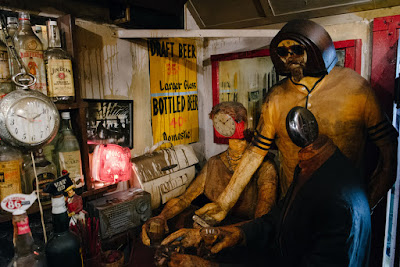 Edward Kienholz was born in Fairfield, Washington to a conservative, working-class family of Swiss descent. He grew up on his parents' wheat farm, where he learned the crafts of metalwork, carpentry, and automobile mechanics. The skills that he acquired as a farmer and the surrounding environment of the rural Northwest would come to inform his later artwork, which incorporates themes of working-class America and displays his deft technical ability.
Edward Kienholz was born in Fairfield, Washington to a conservative, working-class family of Swiss descent. He grew up on his parents' wheat farm, where he learned the crafts of metalwork, carpentry, and automobile mechanics. The skills that he acquired as a farmer and the surrounding environment of the rural Northwest would come to inform his later artwork, which incorporates themes of working-class America and displays his deft technical ability.After earning his high school degree, Kienholz pursued undergraduate studies at the nearby Eastern Washington College of Education and briefly attended Whitworth College in Spokane. As a young adult, Kienholz made a living working various odd jobs. After dropping out of college, he continued to live in Washington and was diversely employed as a nurse in a psychiatric hospital, a manager of a dance band, a used car dealer, a caterer, a decorator, and a handyman. In 1953 Kienholz moved to Los Angeles and began to develop his interest in art, transitioning from his initial fascination with painting to woodwork, which resulted in his first large-scale wooden relief in 1954. His first one-person exhibition took place at Los Angeles's Vons Cafe Galleria in 1955, followed by a solo show at the Coronet Louvre Theater later that year.
Just after his arrival in California, Kienholz quickly became embedded in the burgeoning Los Angeles art scene, acting not only as a prominent visual artist but also as an art dealer, gallerist, and curator. In August 1956, he founded the short-lived NOW Gallery in the Turnabout Theater, where he organized exhibitions of work by local artists. In 1957 he cofounded the Ferus Gallery with curator Walter Hopps, who would later become the director of the Pasadena Museum of Art. According to their official contract, written out on a hotdog wrapper, Hopps selected the gallery's artists while Kienholz oversaw the space's day-to-day management. The artist and poet Robert Alexander was also a central, although unofficial, collaborator in the gallery's programming and administration. From its founding in 1957 through its closing in 1966, Ferus (whose name derives from the Latin word for "wild beast") held a reputation for showcasing new and provocative art. It attracted a diverse following from various facets of the Californian avant-garde, acquiring a reputation as a gathering place for Beat poets and emerging artists including Richard Diebenkorn and Ed Ruscha. Two artists whose ideas and whose work in assemblage had a particularly strong influence on Kienholz were Bruce Conner and Wallace Berman. In 1957, Ferus was raided and temporarily shut down by the Los Angeles Police Department due to the "obscene" content of an exhibition of Conner's art. Kienholz left his post at Ferus in 1958 to devote his attention to his artistic practice and was succeeded by the important Pop art dealer Irving Blum (under whose stewardship Andy Warhol's soup-can paintings were publicly exhibited at Ferus for the very first time in 1962). Kienholz would continue to participate in Ferus's events, showing his work on several occasions before it closed down in 1966.(theartstory.org)





















No comments:
Post a Comment